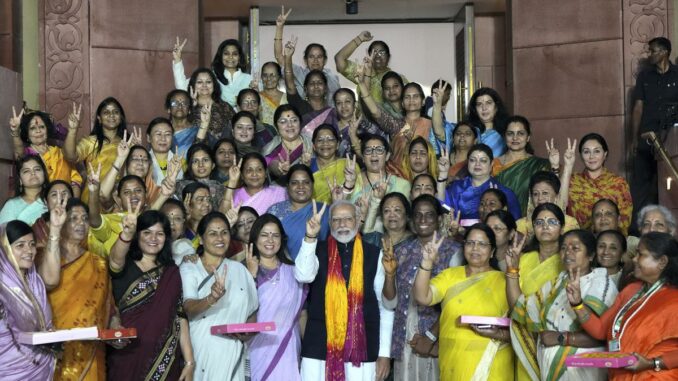
Parliament has committed an egregious folly in fusing women’s reservation with delimitation
“A census to understand the population of women for the purpose of reservation is also unwarranted. The criteria, process and purpose of the Women’s Reservation Bill are qualitatively different from those of the delimitation exercise. And, reservation for women in local bodies, which materialized through the 73rd and 74th Amendment Acts of the Constitution, and came into effect in 1993, was not contingent on any delimitation exercise for that purpose. Parliament, however, has lost sight of these aspects.”

The celebration of the passing of the Women’s Reservation Bill by both Houses of Parliament glosses over certain realities about this conditional legislation. The conduct of a census in the country followed by a delimitation of constituencies based on this census are the conditions for this legislation to take effect. Once it is accepted that reservation for women in legislative bodies is a progressive measure, there is no legal or political justification to prolong its implementation. Speaking in the Lok Sabha, Home Minister Amit Shah justified these conditions saying that there could be legal challenges against the legislation if it is passed without relying on criteria fixed by way of a process of delimitation.
No doubt, a legislation should be based on a solid foundation, and have valid reasons for existence.
In the case of the Women’s Reservation Law, the reality is that about half of the population are women and they are under-represented in Parliament and State legislative bodies. Reports show that, of the maximum allowed 550 seats in the Lok Sabha, only 82, i.e., 15% are represented by women, and out of the 250 members in the Rajya Sabha, only 31, i.e., 12% are women. The Global Gender Gap Report places this in a macroscopic context by showing that India ranks 141 out of 185 in its list.
Contentious issue
Article 81 (2) (a) of the Constitution states that the number of seats in the Lok Sabha for a State should have a co-relation with the population of the State and “so far as practicable”, the criteria should be the same for all States. Article 170, concerning the legislative Assemblies of States, also takes population as the basis for designing constituencies.
However, delimitation in India is a contentious issue. It acts as an incentive for population expansion with scant regard to development and family planning. This was why a full-fledged delimitation was kept in abeyance in India since 1976. It is now expected to be carried out after the Census which will only be held by 2026 at the earliest.
But, as scholar Nilakantan R.S. predicts, this “demographic detonation” will cause “another big fork in the future allocation of political power and associated resources between the north and south”. In his book South vs North (2022), Mr. Nilakantan has demonstrated how South India has performed well in sectors such as health, education, economy etc. in comparison to the North.
South Indian States reduced their population by scientific means whereas North Indian States in general and States such as Uttar Pradesh and Bihar in particular have failed to do so. The South Indian States have raised concerns about this proposed delimitation. This could lead to two outcomes: the delimitation would get prolonged by years which in turn will defer the materialization of the women’s quota law, or it might happen based on population which in turn could translate to undue advantages for certain States in the North.
These are situations that the relevant provisions in the Constitution, namely Articles 81 and 170, failed to foresee. Thus, Parliament has committed an egregious folly in fusing women’s reservation with delimitation.
Articles 330 and 332 of the Constitution deal with the reservation of the Scheduled Caste/Scheduled Tribe (SC/ST) in the Lok Sabha and the Legislative Assembly of States respectively. Though these Articles mention the relationship between reservation and the population of the SC and ST groups, such a parameter is irrelevant to women’s quota. That their share in the total population is almost 50% is undisputed. Further, there cannot be a drastic variation in their population from one constituency to the other, as it could happen with SC or ST.
Unwarranted conditions
A census to understand the population of women for the purpose of reservation is also unwarranted. The criteria, process and purpose of the Women’s Reservation Bill are qualitatively different from those of the delimitation exercise. And, reservation for women in local bodies, which materialized through the 73rd and 74th Amendment Acts of the Constitution, and came into effect in 1993, was not contingent on any delimitation exercise for that purpose. Parliament, however, has lost sight of these aspects.
How far a constitutional Amendment can be done by way of contingent legislation is an issue too, as certainty is regarded as one of the hallmarks of modern constitutions. In Hamdard Dawakhana vs Union of India (1959), the Supreme Court hinted that in conditional legislations, for the statute to take effect, there could be a further dependence on the executive or even on the legislature of the future day, among other things.
Such enactments might be needed on various occasions for multiple reasons. But, by amalgamating the demand for women’s reservation with the uncertainty of a future delimitation process, that too in the case of a constitutional amendment, Parliament has made populist rhetoric at best or committed a constitutional blunder at worst. The secrecy maintained on the subject till the commencement of the special session was also thoroughly undemocratic, which in turn, prevented the exposure of the follies of the legislation.
Therefore, with regard to the future of the women’s quota in the legislature, one can only have the pessimism of the intelligence and optimism of the will, as Antonio Gramsci famously put it, in a different context.
(The author is a lawyer at the Supreme Court of India)





Be the first to comment